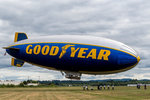
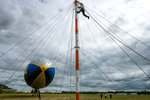
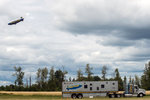
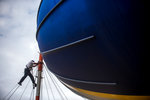
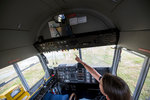
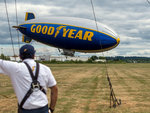
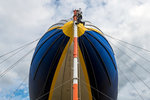
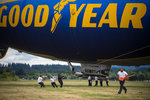
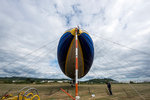
A Goodyear Blimp may not be fast, but it sure knows how to make an entrance.
On Monday afternoon, the famous blimp brought that awe-inspiring prowess to the friendly skies of Lewis County for the second time in just one week.
Last week, the blimp stopped in at the Chehalis-Centralia Airport for an overnight stay as it made its way north to Canada. After spending five days in the great white north and then making a pitstop in Arlington, the blimp and its intrepid crew made its way to Lewis County on Monday.
The flight is part of a 25-day tour from Los Angeles to Canada and back, and it provided Lewis County with a double dose of blimp activity. Typically, the Goodyear Blimp visits the area only once every one or two years. Whenever it happens though, people take notice.
“It gets a lot of people coming down to the airport, so it’s a fun thing,” said Brandon Rakes, airport office manager at the Chehalis-Centralia Airport.
Priscilla Tasker is the airship public relations specialist for Goodyear. She explained that the blimp will be staying in Chehalis for two days before heading south again on its way to Coos Bay, Oregon.
Tasker said the primary function of the Goodyear Blimp is to serve as advertising for the tire company. In order to get the blimp airborne, the crew embarks on three types of flights.
The most well known function of the blimp is as an overhead camera in the sky at major sporting events. Goodyear also offers customer appreciation rides, as well as free rides for kids with disabilities. Tuesday and Wednesday in Lewis County will be customer appreciation days for employees of a few lucky tire companies in the area.
“We’re going to be taking folks for rides,” said Tasker, who estimated that the rides would last 40 to 45 minutes. “It will be local to the area so folks around Chehalis will see us around.”
Tasker added, “The program has been in place for 90 years so if that’s not a testament to its effectiveness, then I don’t know what is.”
Tasker noted that the longest flight any of the blimp pilots have ever completed was a 14-hour flight from Los Angeles to Phoenix.
“It was not by choice,” said Tasker, who noted that stubborn Santa Ana winds made the going more difficult than usual.
For all the hubbub about flying what is essentially a balloon filled with helium attached to a small carriage, it is the landing process that is the most complicated.
Just setting up a landing spot with the proper apparatus can take up to two hours to accomplish, and that’s with a 13-man crew.
“It’s definitely an orchestration,” said Tasker.
Matt St. John was one of the pilots who brought Goodyear to Chehalis on Monday, and he takes the slow speed of travel in stride.
“It’s like the old tortoise and the hare fable. Slow and steady wins the race,” said St. John, who noted that the blimp actually beat the ground crew traveling from Arlington to Chehalis by 45 minutes.
With a top speed of about 50 miles per hour, the blimp can handle most weather conditions reasonably well. Head winds of more than 25 mph will put a damper on things though, as will severe rainstorms or any amount of lightning.
“The hard part is not flying it, it’s getting it back in that harness,” said St. John.
While St. John and his flying partner maneuver the blimp for a final approach, the 13-man crew gets busy on the ground. First, they set up the large landing and docking apparatus that serves to hold the blimp safe and secure in between flights. Then, with the aid of a windsock, the crew forms a human arrow on the ground in order to indicate to the pilot which way the wind is blowing. Once the blimp is hovering just above ground, half the crew races into action to grab the two nose lines that dangle from the front of the blimp. With those lines secured, the other half of the crew hustles in to grab the handles of the gondola cabin for added stability. From there, the crew simply walks the blimp to its docking apparatus, and the show comes to a mesmerizing end.
“They are a well-oiled machine. They know what they’re doing,” said Tasker. “These guys are the experts.”
There are only about 40 certified blimp pilots in the world today, and only three female pilots total. Two of those women are with the Goodyear crew in Chehalis for the West Coast trip. St. John has been a blimp pilot for just over 10 years, and he considers the job to be a childhood dream improbably fulfilled.
“It’s like being a modern day explorer,” said St. John. “We’re used to L.A. Up here it’s just mountains and passes and trees and waterways.”
St. John added that because the Goodyear Blimp makes its home in southern California, the people there are more or less used to seeing it floating around.
“Down there people are so used to seeing us that it’s like their backyard blimp,” said St. John.
Once the crew leaves their home parameters though, they tend to receive a hero’s welcome everywhere they go. On Monday in Chehalis, crowds gathered around the top of the dike surrounding the airport, as well as in the parking lot behind
Walmart and Home Depot. St. John said he could see the crowds waving up at the blimp as they made their descent.
“That never gets old,” said St. John.
Contrary to popular misconception, the blimp does not just come out of its lair for big events. In fact, St. John says it flies nearly every day for about 46 weeks a year. It’s just the big events that garner the most attention. The GZ-20 model blimp that is in Chehalis today is the last of its kind and Goodyear expects to replace it with a newer, larger model by 2017.
“Being in the last one of its type, it’s just a thrill to operate a classic aircraft,” said St. John.
The blimp comes complete with wooden foot pedals to control the rudder and a wooden wheel like that found on a pirate’s ship for controlling altitude. St. John says it is physically demanding job and pilots typically switch back and forth about once every hour. He calls it classic “stick and rudder flying”.
St. John added that he loves getting assigned to fly over open air venues for big events such as the Rose Bowl or USC football games.
“Seeing all of that electricity coming in there is just exciting,” said St. John, who added that he can see more of the action than one might think from his lofty perch. “On game days, you’ll see a lot of circling to the left. That’s so the pilot can look to their left and see right down to the action.”